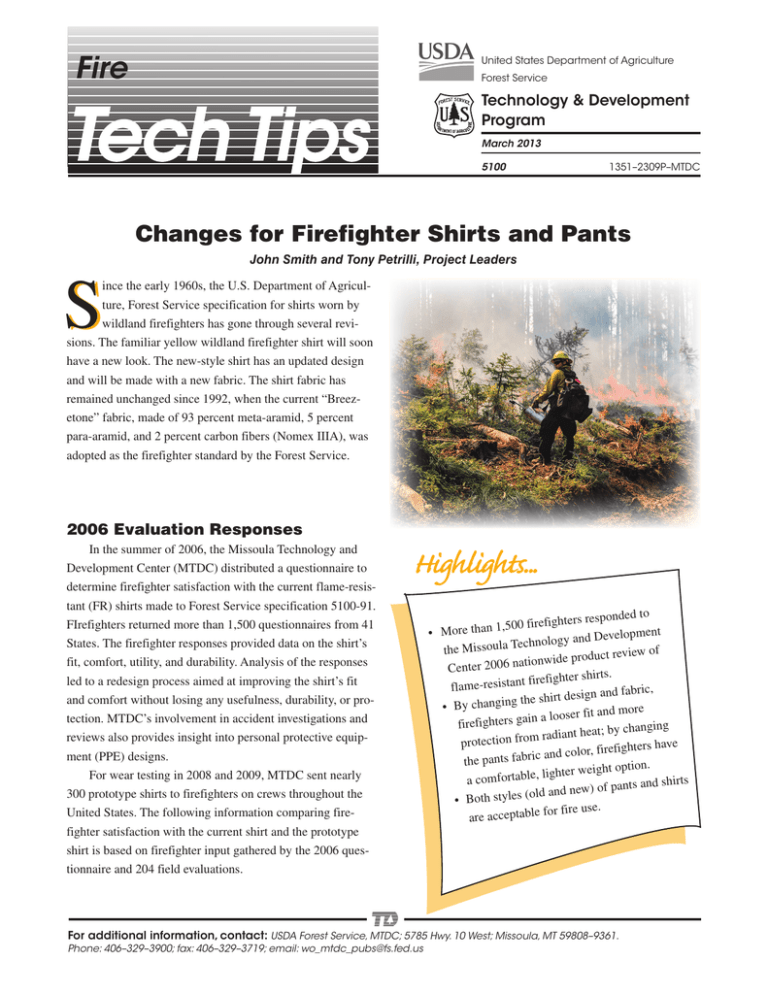Tech Tips S Fire
advertisement

Fire United States Department of Agriculture Forest Service Technology & Development Program Tech Tips March 2013 5100 1351–2309P–MTDC Changes for Firefighter Shirts and Pants S John Smith and Tony Petrilli, Project Leaders ince the early 1960s, the U.S. Department of Agriculture, Forest Service specification for shirts worn by wildland firefighters has gone through several revisions. The familiar yellow wildland firefighter shirt will soon have a new look. The new-style shirt has an updated design and will be made with a new fabric. The shirt fabric has remained unchanged since 1992, when the current “Breezetone” fabric, made of 93 percent meta-aramid, 5 percent para-aramid, and 2 percent carbon fibers (Nomex IIIA), was adopted as the firefighter standard by the Forest Service. 2006 Evaluation Responses In the summer of 2006, the Missoula Technology and Development Center (MTDC) distributed a questionnaire to determine firefighter satisfaction with the current flame-resistant (FR) shirts made to Forest Service specification 5100-91. FIrefighters returned more than 1,500 questionnaires from 41 States. The firefighter responses provided data on the shirt’s fit, comfort, utility, and durability. Analysis of the responses Highlights... led to a redesign process aimed at improving the shirt’s fit and comfort without losing any usefulness, durability, or protection. MTDC’s involvement in accident investigations and reviews also provides insight into personal protective equipment (PPE) designs. For wear testing in 2008 and 2009, MTDC sent nearly 300 prototype shirts to firefighters on crews throughout the United States. The following information comparing firefighter satisfaction with the current shirt and the prototype shirt is based on firefighter input gathered by the 2006 questionnaire and 204 field evaluations. responded to 500 firefighters • More than 1, elopment nology and Dev ch Te a ul so is the M review of nwide product tio na 06 20 r te Cen irts. t firefighter sh flame-resistan and fabric, the shirt design • By changing d more in a looser fit an firefighters ga changing radiant heat; by protection from fighters have and color, fire the pants fabric option. lighter weight a comfortable, nts and shirts and new) of pa ld (o es yl st h • Bot for fire use. are acceptable For additional information, contact: USDA Forest Service, MTDC; 5785 Hwy. 10 West; Missoula, MT 59808–9361. Phone: 406–329–3900; fax: 406–329–3719; email: wo_mtdc_pubs@fs.fed.us Shirt Design Changes FIrefighters identified two areas for improvement: fit through the shoulders and sleeve length. MTDC addresssed these needs by incorporating “bi-swing bellows” into the back and by using a two-piece arm that creates an articulated sleeve. These pattern changes produced a garment with a looser fit through the back, shoulders, chest, and arms while not significantly changing either the chest or sleeve length measurements (figure 1). Firefighters also will find a better sleeve length fit; the sleeve cuff will now stay at the wrist location when arms are extended and will not slide up the forearms of the firefighter. This looser fit is preferable to a tighter fit for three reasons: offers more radiant heat protection, promotes better ventilation that increases cooling since more air can circulate through the garment, and broadens the range of each size to fit more firefighters. Figure 1—The new shirt’s design includes a different collar with Velcro closure and a “bi-swing bellows” back. 2 Because of the looser fit, firefighters may want to wear the next smaller size than they currently wear. In addition to the looser fit, the new shirt design includes three other notable changes: • A redesigned collar with a Velcro tab that provides a more positive closure at the neck for aviation and chain saw operations • The addition of a pen and pencil pocket to the upper left sleeve for easy access • Elbow patches added for extra protection from heat in the most vulnerable area Shirt Fabric Change The 2006 questionnaire also indicated that firefighters considered the current “Breezetone” fabric inadequate in three measures of user comfort; it was rated as too warm, too thick, and too stiff. Many FR fabrics were considered for wear testing. Every fabric under consideration met the requirements of the National Fire Protection Association (NFPA) 1977 Standard on Protective Clothing and Equipment for Wildland Fire Fighting. This ensures the fabrics met the NFPA requirement for thermal protection as well as total heat loss (THL) and strength. To find a fabric more satisfactory to firefighters, MTDC selected eight fabrics and tested them for 2 years. The eight fabrics from five different manufacturers included a modacrylic blend, an FR rayon blend, a polybenzimidazole (Pbi) blend, and various meta-aramid blends. The fabrics also varied in weight and weave types. MTDC selected a new material for the firefighter shirt as a result of wear testing. The fabric selected is actually made from the same blend of fibers as the previous fabric—93 percent meta-aramid, 5 percent para-aramid, and 2 percent carbon fibers. The differences are found in the weave and the weight. The new fabric is a plain weave rather than the modified basket weave of the “Breezetone” fabric. The weight difference is very slight, changing to a weight of 5.5 ounces (per square yard) instead of the current 5.8. These changes, while not dramatic, produced a fabric that the wear testers rated more favorably than the “Breezetone” on all measurements (figure 2). 4.5 4 3.5 5 4.5 4 3.5 3 1.5 2.5 2.1 1 Current fabric 2.5 4.5 4 3.5 2 1.5 1 Current fabric New fabric 2.9 2.5 2.7 2 New fabric 5 3 1 = Too stiff 1 = Too hot 2.5 1 = Too heavy 3 2 Stiffness 5 = Too soft 5 Weight 5 = Too light 5 = Too cold Thermal Comfort 2 2.4 1.5 1 Current fabric New fabric Figure 2—Based on these three measures (thermal comfort, weight, and stiffness), the new fabric was rated higher than the current fabric. In the averaged responses received from wear test participants, a score of 3 equates to a rating of “just right.” The durability of the new fabric also was rated satisfactorily by the wear testers with very few reported weaknesses, such as fabric pilling, tearing, thinning, or fading. The expected life span of the new shirts should be comparable to the current product since the basic fabric is only minimally changed. Great Shirt!! Felt the breathability of the shirt was very helpful. —Wear tester, a member of the Tatanka Hotshot Crew, Black Hills National Forest New Fabric and Color for Pants In continuation of the design changes for firefighter pants, a lighter weight material is now being used for the Type I pants. The fabric is the same twill weave and the same blend of fibers as the current Type I pant fabric—93 percent meta-aramid, 5 percent para-aramid, and 2 percent carbon fibers (Nomex IIIA). The new fabric is, however, one ounce (per square yard) lighter in weight than the current fabric—6.7 down from 7.7. Also, in order to accommodate firefighter feedback desiring a lighter color, the dark spruce color was changed to sage green (figure 3). Figure 3—Type I flame-resistant pants are sage green and made of a fabric that is lighter in weight than the current fabric. 3 Availability of New Shirts and Pants Library Card The shirt and pants ordering information, National Stock Numbers (NSNs) and National Fire Equipment System (NFES) numbers, will remain unchanged allowing the General Services Administration (GSA) and support caches to smoothly transition between the old- and new-style shirts and pants. Shirt and pants orders will be filled with the new styles after GSA depletes its inventory of old styles. Both the oldand the new-style shirts and pants are certified as NFPA 1977 compliant; either style is acceptable for fire use provided it meets other serviceability guidelines, such as cleanliness and condition. Fire shirts and pants can be ordered at <http:// www.gsa.gov/graphics/fas/Interactive_PDF2012_Wildland _Fire_Catalog.pdf> or order a catalog at <http://www.gsa .gov/portal/content/101066>. Petrilli, Tony; Smith, John (retired). 2013. Changes for firefighter shirts and pants. Tech Tip 1351–2309P–MTDC. Missoula, MT: U.S. Department of Agriculture, Forest Service, Missoula Technology and Development Center. 4 p. Firefighters asked for work attire changes to improve fit, comfort, and durability. This tech tip describes changes to firefighter shirts and pants. Keywords: fire, fire fighting, firefighting, flame-resistant, Nomex, PPE, protective clothing, safety at work, wear testing • • Additional single copies of this publication may be About the Authors ordered from: Tony Petrilli is an equipment specialist for the fire and USDA Forest Service aviation and safety and health programs at MTDC. He has a Missoula Technology and Development Center bachelor’s degree in education from Western Montana Col5785 Hwy. 10 West lege. Petrilli began working for the Forest Service in 1982 Missoula, MT 59808–9361 and joined MTDC full time in 2000. He has worked as a firePhone: 406–329–3978 fighter for the Lewis and Clark and Beaverhead National ForFax: 406–329–3719 ests and as a smokejumper for the Northern Region. He is a Email: wo_mtdc_pubs@fs.fed.us division/group supervisor, Type III incident commander, and has served on more than 20 fire entrapment review or investiElectronic copies of MTDC’s publications are available gation teams. on the Internet at: John Smith joined MTDC as an equipment specialist http://www.fs.fed.us/eng/pubs in 2005 and was a project leader until his retirement in 2011. He graduated from the University of Montana with a bachForest Service and Bureau of Land Management elor’s degree in education and taught elementary school in employees can search MTDC’s documents, CDs, DVDs, Ovando, MT. He began his Forest Service career in 1974 as and videos on their internal computer networks at: a wildland firefighter for the Lolo National Forest’s Superior http://fsweb.mtdc.wo.fs.fed.us/search/ Ranger District. A Missoula smokejumper for more than two decades, Smith applied his experience as assistant loadmaster For additional technical information, contact MTDC: foreman and master parachute rigger to developing equipPhone: 406–329–3900 ment for firefighters. Fax: 406–329–3719 The Forest Service, an agency of the U.S. Department of Agriculture (USDA), has developed this information for the guidance of its employees, its contractors, and its cooperating Federal and State agencies. The Forest Service assumes no responsibility for the interpretation or use of this information by anyone except its own employees. The use of trade, firm, or corporation names is for the information and convenience of the reader. Such use does not constitute an official endorsement or approval of any product or service to the exclusion of others that may be suitable. The U.S. Department of Agriculture (USDA) prohibits discrimination in all its programs and activities on the basis of race, color, national origin, age, disability, and where applicable, sex, marital status, familial status, parental status, religion, sexual orientation, genetic information, political beliefs, reprisal, or because all or part of an individual’s income is derived from any public assistance program. (Not all prohibited bases apply to all programs.) Persons with disabilities who require alternative means for communication of program information (Braille, large print, audiotape, etc.) should contact USDA’s TARGET Center at (202) 720-2600 (voice and TDD). To file a complaint of discrimination, write USDA, Director, Office of Civil Rights, 1400 Independence Avenue, S.W., Washington, D.C. 20250-9410, or call (800) 795-3272 (voice) or (202) 720-6382 (TDD). USDA is an equal opportunity provider and employer. 4





